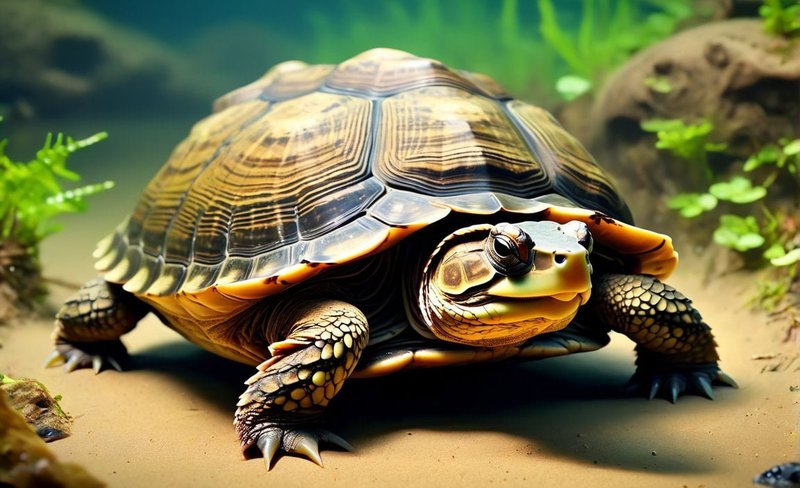
Snapping turtles belong to the family Chelydridae, and they can be found in freshwater habitats across North America. Known for their powerful jaws and often grumpy demeanor, they have a presence that commands respect. Whether you’re a nature enthusiast, a budding herpetologist, or just someone who’s curious about the natural world, there’s a lot to learn about these majestic creatures. So, let’s explore ten captivating facts about snapping turtles that you might not know!
1. Powerful Jaws and Bite Forces
One of the most striking features of snapping turtles is their incredibly powerful jaws. They have a bite force that can reach up to 1,000 pounds per square inch! That’s enough to crush bones and even bite through large prey like fish and small mammals. When you think about it, that’s like having a bite stronger than the jaws of a lion!
These turtles primarily use their strong jaws for hunting and defense. If you ever find yourself near a snapping turtle and it feels threatened, beware! They can snap their jaws quickly and with great force. This snapping motion isn’t just for show; it’s their way of protecting themselves and getting their next meal. Honestly, you wouldn’t want to stick your fingers too close for a “friendly” interaction!
2. They Can Live for Decades
Snapping turtles are among the longest-living reptiles. In the wild, they can live anywhere from 30 to 40 years, and some have even been known to live over 100 years in captivity. Here’s the thing: this longevity is quite remarkable considering the various threats they face, such as habitat loss and pollution.
Their slow growth and late maturity mean that snapping turtles don’t reproduce until they’re about 20 years old. This long life gives them plenty of time to adapt to changing environments and find mates, ensuring the continuation of their species. It’s like they’re the wise old sages of the turtle world!
3. Unique Hunting Strategies
You might be surprised to learn that snapping turtles are ambush predators. They don’t typically chase down their food; instead, they lie in wait at the bottom of lakes or rivers for fish or other unsuspecting prey to swim by. Imagine a stealthy ninja, camouflaged in the murky water, ready to strike.
When a fish swims too close, the snapping turtle uses its powerful jaws to snap it up quickly. They also have a fascinating adaptation: their tongues can mimic the appearance of a worm, luring in curious fish. That’s some serious tactical thinking for a turtle!
4. Their Shells Are More Than Just Protection
The hard shell of a snapping turtle is not just armor; it serves several vital functions. First, it protects them from predators, allowing them to retreat into their shell when danger approaches. But their shell is also layered with bones that provide vital support for their body.
Interestingly, the color and texture of their shells can change over time, blending in with their environment. This helps with camouflage, making it harder for both predators and prey to spot them. So, while they might look like a grumpy old rock sitting at the bottom of the pond, they’re actually well-adapted masters of disguise!
5. They’re Not Great Swimmers
You might assume that snapping turtles, like other turtles, are excellent swimmers. While they do swim, they aren’t quite as graceful in the water as you might think. Their heavy, bulky bodies make it challenging for them to maneuver quickly. They tend to prefer walking along the bottom rather than gliding through the water.
In fact, if you see one swimming, it might look a bit like a small submarine struggling to stay afloat. They do have strong legs to help push themselves through, but you won’t catch them racing with the fish anytime soon!
6. Their Sense of Smell Is Impressive
Snapping turtles rely heavily on their sense of smell when hunting for food. They have an excellent olfactory system that allows them to detect odors from quite a distance. This skill is especially useful when they’re looking for food, as it helps them locate prey even when it’s hiding in vegetation or debris.
If you ever observe a snapping turtle in shallow water, you’ll see it often moving its head around, sniffing the water. It’s like they’re constantly on a treasure hunt, seeking out their next meal. With such a keen sense of smell, it’s no wonder they’re so successful in their aquatic environment.
7. Unique Breeding Behavior
When it comes to breeding, snapping turtles have some interesting practices. Mating usually takes place in the spring or early summer. Males often engage in intense courtship displays, sometimes engaging in a battle of strength to win over a female. It’s a bit like watching a duel between two knights, each vying for the lady’s favor.
After mating, females venture onto land to lay their eggs, typically in sandy or soft soil. They can lay between 20 and 50 eggs in a single clutch. After laying their eggs, the female leaves them to incubate on their own. The eggs will hatch after about 80 to 90 days, usually in late summer. It’s fascinating to think about how these little hatchlings begin their lives, independent right from the start!
8. Snapping Turtles Can Be Found Almost Everywhere
From the swamps of the Southeast to the rivers of the North, snapping turtles are highly adaptable and can be found in a variety of habitats. They thrive in ponds, lakes, rivers, and wetlands, demonstrating their resilience and versatility.
You might be wondering how to spot one in the wild. Look for their distinctive shells floating on the water’s surface or sunbathing on rocks or logs. Their rough, rugged shells make them blend seamlessly into the environment, so stay alert if you’re out exploring nature!
9. They Have a Unique Defense Mechanism
When threatened, snapping turtles might not rely solely on their jaws as a defense mechanism. Instead, they often exhibit a behavior called “playing dead.” This strategy involves retreating into their shells and remaining very still. It’s like they’re hoping that by playing dead, their potential predators will lose interest.
While this tactic can sometimes work, snapping turtles are also known to hiss loudly and whip their tails if someone gets too close. This makes them seem larger and more intimidating, which can deter curious onlookers. So, if you ever feel tempted to approach one, keep that impressive hissing sound in mind!
10. They Play a Vital Role in Ecosystems
Snapping turtles are essential contributors to their ecosystems. As omnivores, they help keep populations of fish, amphibians, and other aquatic creatures in check. By preying on these animals, they help maintain a healthy balance in their habitats.
Moreover, snapping turtles contribute to nutrient cycling in aquatic environments. When they feed on carrion or decaying plant matter, they help break it down, returning nutrients to the ecosystem. This interaction supports the growth of various plant and animal life, making snapping turtles vital players in preserving ecological balance.
—
In conclusion, snapping turtles are truly remarkable creatures with a wealth of fascinating traits. Whether it’s their powerful bite, impressive longevity, or essential ecological role, these turtles deserve our respect and protection. Next time you see a snapping turtle, take a moment to appreciate all the incredible attributes that make them such unique members of the animal kingdom. Embracing the beauty of these creatures enriches our understanding of the world around us!

